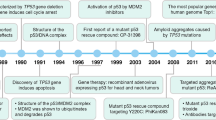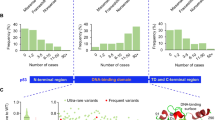Abstract
The E2F1 transcription factor is a critical downstream target of the tumor suppressor RB. When activated, E2F1 induces cell proliferation. In addition, E2F1 can induce apoptosis via both p53-dependent and p53-independent pathways. A number of E2F-regulated genes, including ARF, ATM and Chk2, contribute to E2F-induced p53 stabilization. However, it is not known how E2F directs p53 activity towards apoptosis rather than growth arrest. We show that E2F1 upregulates the expression of four proapoptotic cofactors of p53 – ASPP1, ASPP2, JMY and TP53INP1 – through a direct transcriptional mechanism. Adenovirus E1A protein also induces upregulation of these genes, implicating endogenous E2F in this effect. TP53INP1 was shown to mediate phosphorylation of p53 on serine 46. We demonstrate that activation of E2F1 leads to phosphorylation of p53 on serine 46 and this modification is important for E2F1–p53 cooperation in apoptosis. Overall, these data provide novel functional links between RB/E2F pathway and p53-induced apoptosis.
Similar content being viewed by others
Log in or create a free account to read this content
Gain free access to this article, as well as selected content from this journal and more on nature.com
or
Abbreviations
- ChIP:
-
chromatin immunoprecipitation
- CHX:
-
cycloheximide
- ER:
-
estrogen receptor
- FCS:
-
fetal calf serum
- OHT:
-
4-hydroxytamoxifen
References
DeGregori J (2002) The genetics of the E2F family of transcription factors: shared functions and unique roles. Biochim. Biophys. Acta 1602: 131–150
Ginsberg D (2002) E2F1 pathways to apoptosis. FEBS Lett. 529: 122–125
Qin XQ, Livingston DM, Kaelin Jr WG and Adams PD (1994) Deregulated transcription factor E2F-1 expression leads to S-phase entry and p53-mediated apoptosis. Proc. Natl. Acad. Sci. USA 91: 10918–10922
Wu X and Levine AJ (1994) p53 and E2F-1 cooperate to mediate apoptosis. Proc. Natl. Acad. Sci. USA 91: 3602–3606
Kowalik TF, DeGregori J, Schwarz JK and Nevins JR (1995) E2F1 overexpression in quiescent fibroblasts leads to induction of cellular DNA synthesis and apoptosis. J. Virol. 69: 2491–2500
Guy CT, Zhou W, Kaufman S and Robinson MO (1996) E2F-1 blocks terminal differentiation and causes proliferation in transgenic megakaryocytes. Mol. Cell. Biol. 16: 685–693
Holmberg C, Helin K, Sehested M and Karlstrom O (1998) E2F-1-induced p53-independent apoptosis in transgenic mice. Oncogene 17: 143–155
Pierce AM, Fisher SM, Conti CJ and Johnson DG (1998) Deregulated expression of E2F1 induces hyperplasia and cooperates with ras in skin tumor development. Oncogene 16: 1267–1276
Field SJ, Tsai FY, Kuo F, Zubiaga AM, Kaelin WJ, Livingston DM, Orkin SH and Greenberg ME (1996) E2F-1 functions in mice to promote apoptosis and suppress proliferation. Cell 85: 549–561
Sherr CJ and Weber JD (2000) The ARF/p53 pathway. Curr. Opin. Genet. Dev. 10: 94–99
Rogoff HA, Pickering MT, Debatis ME, Jones S and Kowalik TF (2002) E2F1 induces phosphorylation of p53 that is coincident with p53 accumulation and apoptosis. Mol. Cell. Biol. 22: 5308–5318
Russell JL, Powers JT, Rounbehler RJ, Rogers PM, Conti CJ and Johnson DG (2002) ARF differentially modulates apoptosis induced by E2F1 and Myc. Mol. Cell. Biol. 22: 1360–1368
Tolbert D, Lu X, Yin C, Tantama M and Van Dyke T (2002) p19(ARF) is dispensable for oncogenic stress-induced p53-mediated apoptosis and tumor suppression in vivo. Mol. Cell. Biol. 22: 370–377
Tsai KY, MacPherson D, Rubinson DA, Crowley D and Jacks T (2002) ARF is not required for apoptosis in Rb mutant mouse embryos. Curr. Biol. 12: 159–163
Berkovich E and Ginsberg D (2003) ATM is a target for positive regulation by E2F-1. Oncogene 22: 161–167
Powers JT, Hong S, Mayhew CN, Rogers PM, Knudsen ES and Johnson DG (2004) E2F1 uses the ATM signaling pathway to induce p53 and Chk2 phosphorylation and apoptosis. Mol. Cancer Res. 2: 203–214
Rogoff HA, Pickering MT, Frame FM, Debatis ME, Sanchez Y, Jones S and Kowalik TF (2004) Apoptosis associated with deregulated E2F activity is dependent on E2F1 and Atm/Nbs1/Chk2. Mol. Cell. Biol. 24: 2968–2977
Hiebert SW, Packham G, Strom DK, Haffner R, Oren M, Zambetti G and Cleveland JL (1995) E2F-1 : DP-1 induces p53 and overrides survival factors to trigger apoptosis. Mol. Cell. Biol. 15: 6864–6874
Ko LJ and Prives C (1996) p53: puzzle and paradigm. Genes Dev. 10: 1054–1072
Samuels-Lev Y, O'Connor DJ, Bergamaschi D, Trigiante G, Hsieh JK, Zhong S, Campargue I, Naumovski L, Crook T and Lu X (2001) ASPP proteins specifically stimulate the apoptotic function of p53. Mol. Cell 8: 781–794
Shikama N, Lee CW, France S, Delavaine L, Lyon J, Krstic-Demonacos M and La Thangue NB (1999) A novel cofactor for p300 that regulates the p53 response. Mol. Cell 4: 365–376
Okamura S, Arakawa H, Tanaka T, Nakanishi H, Ng CC, Taya Y, Monden M and Nakamura Y (2001) p53DINP1, a p53-inducible gene, regulates p53-dependent apoptosis. Mol. Cell 8: 85–94
Bergamaschi D, Samuels Y, O'Neil NJ, Trigiante G, Crook T, Hsieh JK, O'Connor DJ, Zhong S, Campargue I, Tomlinson ML, Kuwabara PE and Lu X (2003) iASPP oncoprotein is a key inhibitor of p53 conserved from worm to human. Nat. Genet. 33: 162–167
Slee EA, Gillotin S, Bergamaschi D, Royer C, Llanos S, Ali S, Jin B, Trigiante G and Lu X (2004) The N-terminus of a novel isoform of human iASPP is required for its cytoplasmic localization. Oncogene 23: 9007–9016
Tomasini R, Samir AA, Vaccaro MI, Pebusque MJ, Dagorn JC, Iovanna JL and Dusetti NJ (2001) Molecular and functional characterization of the stress-induced protein (SIP) gene and its two transcripts generated by alternative splicing. SIP induced by stress and promotes cell death. J. Biol. Chem. 276: 44185–44192
Tomasini R, Samir AA, Pebusque MJ, Calvo EL, Totaro S, Dagorn JC, Dusetti NJ and Iovanna JL (2002) P53-dependent expression of the stress-induced protein (SIP). Eur. J. Cell Biol. 81: 294–301
Tomasini R, Samir AA, Carrier A, Isnardon D, Cecchinelli B, Soddu S, Malissen B, Dagorn JC, Iovanna JL and Dusetti NJ (2003) TP53INP1s and homeodomain-interacting protein kinase-2 (HIPK2) are partners in regulating p53 activity. J. Biol. Chem. 278: 37722–37729
Vigo E, Muller H, Prosperini E, Hateboer G, Cartwright P, Moroni MC and Helin K (1999) CDC25A phosphatase is a target of E2F and is required for efficient E2F-induced S phase. Mol. Cell. Biol. 19: 6379–6395
Weinmann AS, Yan PS, Oberley MJ, Huang TH and Farnham PJ (2002) Isolating human transcription factor targets by coupling chromatin immunoprecipitation and CpG island microarray analysis. Genes Dev. 16: 235–244
Bates S, Phillips AC, Clark PA, Stott F, Peters G, Ludwig RL and Vousden KH (1998) p14ARF links the tumour suppressors RB and p53 (letter). Nature 395: 124–125
Chehab NH, Malikzay A, Appel M and Halazonetis TD (2000) Chk2/hCds1 functions as a DNA damage checkpoint in G(1) by stabilizing p53. Genes Dev. 14: 278–288
Hirao A, Kong YY, Matsuoka S, Wakeham A, Ruland J, Yoshida H, Liu D, Elledge SJ and Mak TW (2000) DNA damage-induced activation of p53 by the checkpoint kinase Chk2. Science 287: 1824–1827
Shieh SY, Ahn J, Tamai K, Taya Y and Prives C (2000) The human homologs of checkpoint kinases Chk1 and Cds1 (Chk2) phosphorylate p53 at multiple DNA damage-inducible sites. Genes Dev. 14: 289–300
Ryo A, Liou YC, Wulf G, Nakamura M, Lee SW and Lu KP (2002) PIN1 is an E2F target gene essential for Neu/Ras-induced transformation of mammary epithelial cells. Mol. Cell. Biol. 22: 5281–5295
Zacchi P, Gostissa M, Uchida T, Salvagno C, Avolio F, Volinia S, Ronai Z, Blandino G, Schneider C and Del Sal G (2002) The prolyl isomerase Pin1 reveals a mechanism to control p53 functions after genotoxic insults. Nature 419: 853–857
Zheng H, You H, Zhou XZ, Murray SA, Uchida T, Wulf G, Gu L, Tang X, Lu KP and Xiao ZX (2002) The prolyl isomerase Pin1 is a regulator of p53 in genotoxic response. Nature 419: 849–853
Bergamaschi D, Samuels Y, Jin B, Duraisingham S, Crook T and Lu X (2004) ASPP1 and ASPP2: common activators of p53 family members. Mol. Cell. Biol. 24: 1341–1350
Oda K, Arakawa H, Tanaka T, Matsuda K, Tanikawa C, Mori T, Nishimori H, Tamai K, Tokino T, Nakamura Y and Taya Y (2000) p53AIP1, a potential mediator of p53-dependent apoptosis, and its regulation by Ser-46-phosphorylated p53. Cell 102: 849–862
Hofmann TG, Moller A, Sirma H, Zentgraf H, Taya Y, Droge W, Will H and Schmitz ML (2002) Regulation of p53 activity by its interaction with homeodomain-interacting protein kinase-2. Nat. Cell Biol. 4: 1–10
D'Orazi G, Cecchinelli B, Bruno T, Manni I, Higashimoto Y, Saito S, Gostissa M, Coen S, Marchetti A, Del Sal G, Piaggio G, Fanciulli M, Appella E and Soddu S (2002) Homeodomain-interacting protein kinase-2 phosphorylates p53 at Ser 46 and mediates apoptosis. Nat. Cell Biol. 4: 11–19
Oda E, Ohki R, Murasawa H, Nemoto J, Shibue T, Yamashita T, Tokino T, Taniguchi T and Tanaka N (2000) Noxa, a BH3-only member of the Bcl-2 family and candidate mediator of p53-induced apoptosis. Science 288: 1053–1058
Guo Z, Yikang S, Yoshida H, Mak TW and Zacksenhaus E (2001) Inactivation of the retinoblastoma tumor suppressor induces apoptosis protease-activating factor-1 dependent and independent apoptotic pathways during embryogenesis. Cancer Res. 61: 8395–8400
Moroni MC, Hickman ES, Denchi EL, Caprara G, Colli E, Cecconi F, Muller H and Helin K (2001) Apaf-1 is a transcriptional target for E2F and p53. Nat. Cell Biol. 3: 552–558
Nakano K and Vousden KH (2001) PUMA, a novel proapoptotic gene, is induced by p53. Mol. Cell 7: 683–694
Robles AI, Bemmels NA, Foraker AB and Harris CC (2001) APAF-1 is a transcriptional target of p53 in DNA damage-induced apoptosis. Cancer Res. 61: 6660–6664
Yu J, Zhang L, Hwang PM, Kinzler KW and Vogelstein B (2001) PUMA induces the rapid apoptosis of colorectal cancer cells. Mol. Cell 7: 673–682
Hershko T and Ginsberg D (2004) Up-regulation of Bcl-2 homology 3 (BH3)-only proteins by E2F1 mediates apoptosis. J. Biol. Chem. 279: 8627–8634
Fortin A, MacLaurin JG, Arbour N, Cregan SP, Kushwaha N, Callaghan SM, Park DS, Albert PR and Slack RS (2004) The proapoptotic gene SIVA is a direct transcriptional target for the tumor suppressors p53 and E2F1. J. Biol. Chem. 279: 28706–28714
Kalma Y, Marash L, Lamed Y and Ginsberg D (2001) Expression analysis using DNA microarrays demonstrates that E2F-1 up-regulates expression of DNA replication genes including replication protein A2. Oncogene 20: 1379–1387
Acknowledgements
We are grateful to Yocheved Lamed for excellent technical assistance. We thank Karen Vousden and Xin Lu for communicating results prior to publication. We also thank Xin Lu for antibodies to ASPP1 and ASPP2 and Yoichi Taya for the pC53-SNS-S46A plasmid. This work was supported by an Israel Science Foundation (ISF) grant to DG, and by grant R37 CA40099 from the National Cancer Institute to MO. MC was supported by a Pasteur-Weizmann post-doctoral fellowship.
Author information
Authors and Affiliations
Corresponding author
Additional information
Edited by G Melino
Rights and permissions
About this article
Cite this article
Hershko, T., Chaussepied, M., Oren, M. et al. Novel link between E2F and p53: proapoptotic cofactors of p53 are transcriptionally upregulated by E2F. Cell Death Differ 12, 377–383 (2005). https://doi.org/10.1038/sj.cdd.4401575
Received:
Revised:
Accepted:
Published:
Issue date:
DOI: https://doi.org/10.1038/sj.cdd.4401575
Keywords
This article is cited by
-
EGR-1/ASPP1 inter-regulatory loop promotes apoptosis by inhibiting cyto-protective autophagy
Cell Death & Disease (2017)
-
Oxidative stress-induced p53 activity is enhanced by a redox-sensitive TP53INP1 SUMOylation
Cell Death & Differentiation (2014)
-
JMY protein, a regulator of P53 and cytoplasmic actin filaments, is expressed in normal and neoplastic tissues
Virchows Archiv (2014)
-
Gene interaction enrichment and network analysis to identify dysregulated pathways and their interactions in complex diseases
BMC Systems Biology (2012)
-
An indirect role for ASPP1 in limiting p53-dependent p21 expression and cellular senescence
The EMBO Journal (2012)



